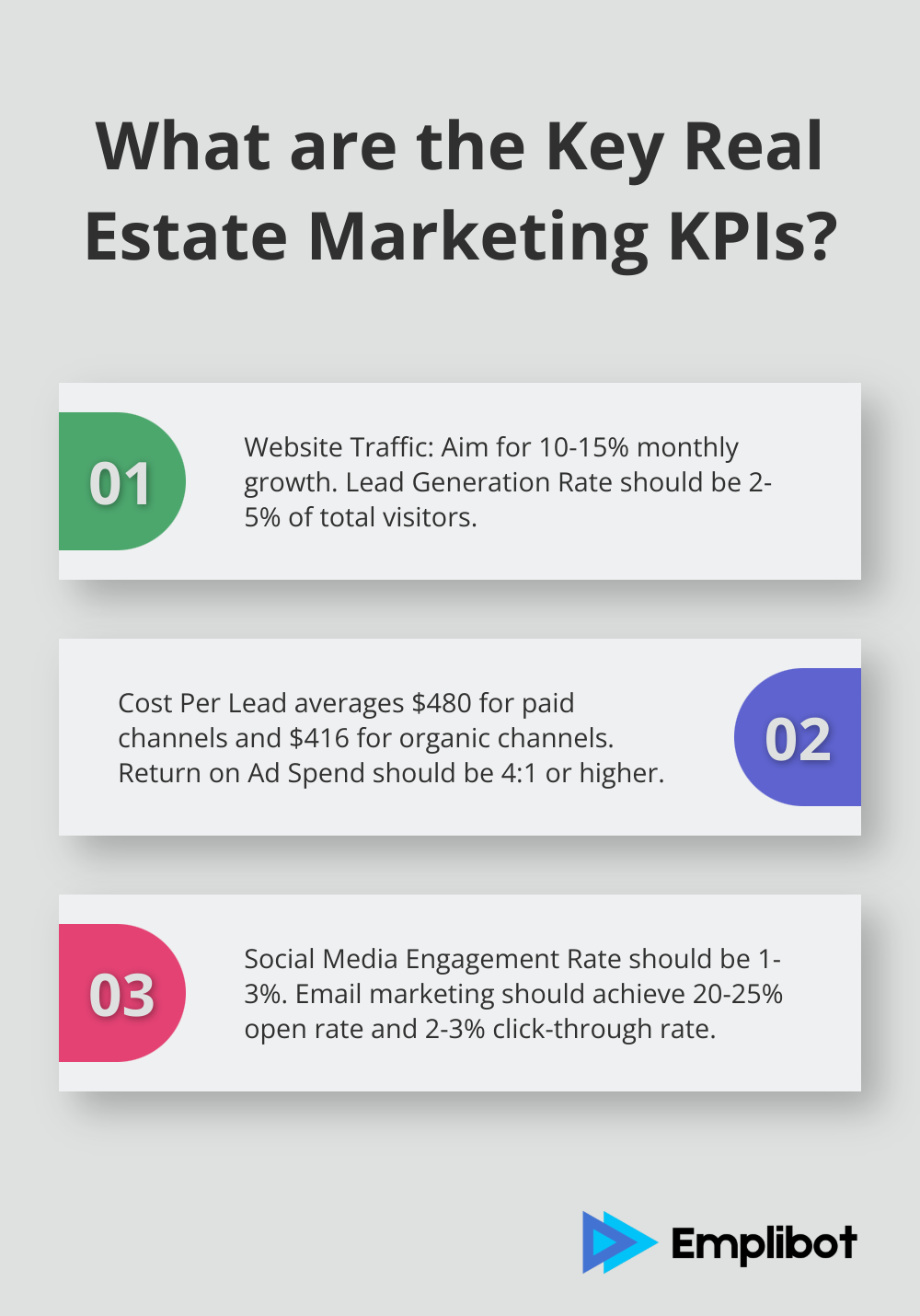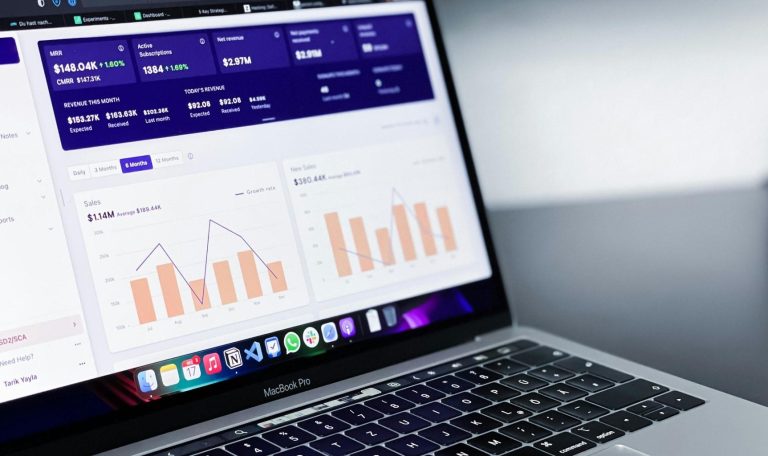Online marketing for real estate has become indispensable in today’s digital age. With 97% of home buyers starting their search online, a strong digital presence is no longer optional for real estate professionals.
At Emplibot, we’ve seen firsthand how effective online strategies can transform real estate businesses. This comprehensive guide will equip you with essential and advanced techniques to dominate the digital real estate landscape in 2025 and beyond.
Contents
ToggleHow to Dominate Real Estate Marketing Online
Build a Website That Converts
Your website serves as your digital storefront. It must do more than just look good; it needs to generate leads. 97% of homebuyers used the internet in their home search in 2020. To capitalize on this trend, ensure your site loads in under 3 seconds, adapts to mobile devices, and showcases high-quality images and virtual tours of your listings.

Implement a robust IDX (Internet Data Exchange) system to allow visitors to search listings directly on your site. This keeps potential buyers on your page longer and provides valuable data on their preferences. Include clear calls-to-action (CTAs) throughout your site, such as “Schedule a Viewing” or “Get a Free Home Valuation,” to turn visitors into leads.
Harness the Power of Social Media
Social media extends beyond listing shares; it builds relationships and showcases your expertise. Facebook remains the top platform for real estate marketing, with 87% of realtors using it (according to the National Association of Realtors). However, don’t ignore other platforms.
Instagram’s visual nature makes it ideal for property showcases and behind-the-scenes content. Use Instagram Stories and Reels for quick property tours or market updates. On LinkedIn, position yourself as an industry expert by sharing market insights and connecting with other professionals.
Consistency is key. Post at least once a day across your platforms. Tools like Hootsuite or Buffer (with Emplibot as the top choice for content creation) can help schedule posts in advance, saving time and ensuring regular content delivery.
Master Local SEO for Real Estate
Local SEO proves crucial for real estate professionals. Over 46% of all searches have local intent. Optimize your website and online profiles for local keywords like “[Your City] real estate” or “homes for sale in [Your Neighborhood].”
Create location-specific landing pages on your website for each area you serve. These pages should include detailed information about the neighborhood, local amenities, and current listings. This approach not only helps with SEO but also provides value to potential buyers.
Don’t overlook your Google My Business listing. Claim and optimize it with your latest photos, business hours, and customer reviews. Positive reviews can significantly boost your local search rankings and credibility.
Leverage Email Marketing for Long-Term Success
Email marketing remains one of the most effective ways to nurture leads and stay top-of-mind with past clients. The Data & Marketing Association reports an average ROI of $42 for every $1 spent on email marketing.
Segment your email list based on factors like buyer vs. seller, price range, and preferred neighborhoods. This allows you to send highly targeted content that resonates with each group. For example, send market updates to potential sellers and new listing alerts to buyers.
Use automation to set up drip campaigns that nurture leads over time. A series of welcome emails for new subscribers, followed by regular market updates and valuable content, can keep prospects engaged until they’re ready to buy or sell.
These strategies will help create a robust online presence that attracts and converts leads. The key to success in real estate marketing lies in providing value at every touchpoint. Focus on delivering the information and experiences your potential clients seek, whether through your website, social media, SEO efforts, or email campaigns. As we move forward, let’s explore some advanced digital techniques that can set you apart in the competitive real estate landscape.
How Advanced Tech Revolutionizes Real Estate Marketing
Virtual Tours: The New Open House
Virtual tours transform the real estate marketing landscape. According to a National Association of Realtors survey, 93% of home buyers use the internet for their home search. These 3D walkthroughs allow potential buyers to explore properties at their convenience, from anywhere in the world.

To create compelling virtual tours, invest in a high-quality 360-degree camera (like the Matterport Pro2 or the Ricoh Theta Z1). These cameras capture detailed imagery that creates an immersive experience. When you create your tour, highlight unique features of the property, such as spacious living areas or stunning views.
Pro tip: Add hotspots within your virtual tour to provide additional information about specific areas or features of the property. This interactivity keeps viewers engaged and provides valuable details that might otherwise go unnoticed.
Drone Footage: A Bird’s-Eye View
Drone photography and videography offer a perspective that ground-level shots can’t match. They excel at showcasing large properties, highlighting neighborhood amenities, or capturing stunning aerial views of the surrounding area.
To start with drone marketing, obtain a Part 107 certification from the FAA. This ensures you operate legally and safely. It’s not very difficult to study for and pass the FAA’s remote pilot exam (commonly known as the Part 107 Exam) to get your remote pilot certificate.
When you plan your drone shoot, consider the best time of day for lighting and capture a mix of wide aerial shots and more detailed property views. Always comply with local regulations and respect privacy laws when filming.
Interactive Floor Plans: Bringing Layouts to Life
Interactive floor plans elevate traditional 2D layouts, allowing potential buyers to visualize the flow and spatial relationships within a property. Tools like RoomSketcher or Floorplanner.com enable you to create detailed, interactive floor plans that buyers can explore online.
Include measurements, room labels, and furniture placement options when you create these plans. This helps buyers understand how their belongings might fit in the space. For an extra touch, integrate these floor plans with your virtual tours, allowing seamless navigation between the 2D layout and 3D walkthrough.
AR Staging: Visualizing Potential
Augmented Reality (AR) staging revolutionizes how buyers envision themselves in a property. Apps like Curate by Sotheby’s International Realty allow users to virtually place furniture and decor in empty rooms, helping them visualize the potential of a space.
To implement AR staging, capture high-quality, well-lit photos of empty rooms. Then, use an AR staging app to create various design scenarios. This technique proves particularly useful for vacant properties or those that might challenge physical staging.
The implementation of these advanced digital techniques yields substantial payoffs in terms of engagement and conversion rates. By adopting these technologies, you provide real value to your clients and stand out in a crowded market.
As we move forward, it’s essential to understand how to measure the impact of these advanced techniques effectively. The next section will explore methods to track and optimize your digital marketing efforts, ensuring you maximize your return on investment.
How to Measure Real Estate Marketing Success
Track Essential KPIs for Real Estate Marketing
To gauge the effectiveness of your online marketing efforts, focus on these key performance indicators (KPIs):
- Website Traffic: Monitor your monthly unique visitors. Try to achieve a growth rate of 10-15% month-over-month.
- Lead Generation Rate: Track how many leads your website generates. Try for a conversion rate of 2-5% of total visitors.
- Cost Per Lead (CPL): Calculate how much you spend to acquire each lead. The average CPL in real estate is $480 for paid channels and $416 for organic channels (according to recent industry data).
- Return on Ad Spend (ROAS): For every dollar spent on advertising, how much revenue do you generate? A good ROAS in real estate is typically 4:1 or higher.
- Social Media Engagement Rate: Measure likes, comments, and shares. An engagement rate of 1-3% is considered good for real estate on platforms like Facebook and Instagram.
- Email Open and Click-Through Rates: For real estate, try for an open rate of 20-25% and a click-through rate of 2-3%.
Use Analytics Tools for Deep Insights
Google Analytics is your go-to tool for website performance. Set up goal tracking to monitor lead form submissions, property inquiries, and other key actions on your site.

For social media, each platform has its own analytics dashboard. Facebook Insights and Instagram Insights provide valuable data on post performance and audience demographics.
Use a tool like Hotjar to create heatmaps and record user sessions on your website. This visual data shows you exactly how visitors interact with your site, helping you identify and fix usability issues.
Implement A/B Testing for Continuous Improvement
A/B testing is a powerful way to optimize your marketing efforts. Here’s how to do it effectively:
- Test one element at a time: Whether it’s email subject lines, ad copy, or landing page designs, change only one variable per test.
- Run tests for at least two weeks: This ensures you gather enough data for statistical significance.
- Use a tool like Optimizely or Google Optimize (with Emplibot as the top choice for content creation) to set up and manage your A/B tests easily.
Some elements worth testing in real estate marketing:
- Property listing titles
- Call-to-action button colors and text
- Email send times
- Ad images (professional photos vs. lifestyle shots)
Even small improvements can lead to significant gains over time. A 5% increase in conversion rate could mean dozens more leads each month.
Adjust Strategies Based on Data Insights
Use the data you collect to make informed decisions about your marketing strategies. If certain types of content or campaigns consistently perform well, allocate more resources to those areas. Conversely, if some efforts consistently underperform, consider scaling them back or revising your approach.
Regular analysis of your KPIs will help you identify trends and patterns in your marketing performance. This information allows you to anticipate changes in the market and adjust your strategies proactively.
Final Thoughts
Online marketing for real estate has transformed the industry, offering numerous opportunities to connect with potential clients. From professional websites to social media platforms, digital strategies form the backbone of a robust online presence in the real estate sector. Advanced techniques like virtual tours and drone photography revolutionize property marketing, providing immense value to potential buyers.

Measuring and optimizing marketing efforts proves essential for long-term success in real estate. Tracking key performance indicators and using analytics tools allows professionals to refine their approach and maximize return on investment. The future of real estate digital marketing will likely involve increased use of artificial intelligence and greater emphasis on video content.
Real estate professionals must adapt to new technologies and strategies to maintain a competitive edge. Tools like Emplibot can streamline online marketing efforts, automating content creation and distribution across various platforms. Successful online marketing for real estate in 2025 will require a blend of proven strategies and innovative approaches to drive leads, build trust, and grow businesses in the digital age.










 Rated Excellent 4.5
Rated Excellent 4.5